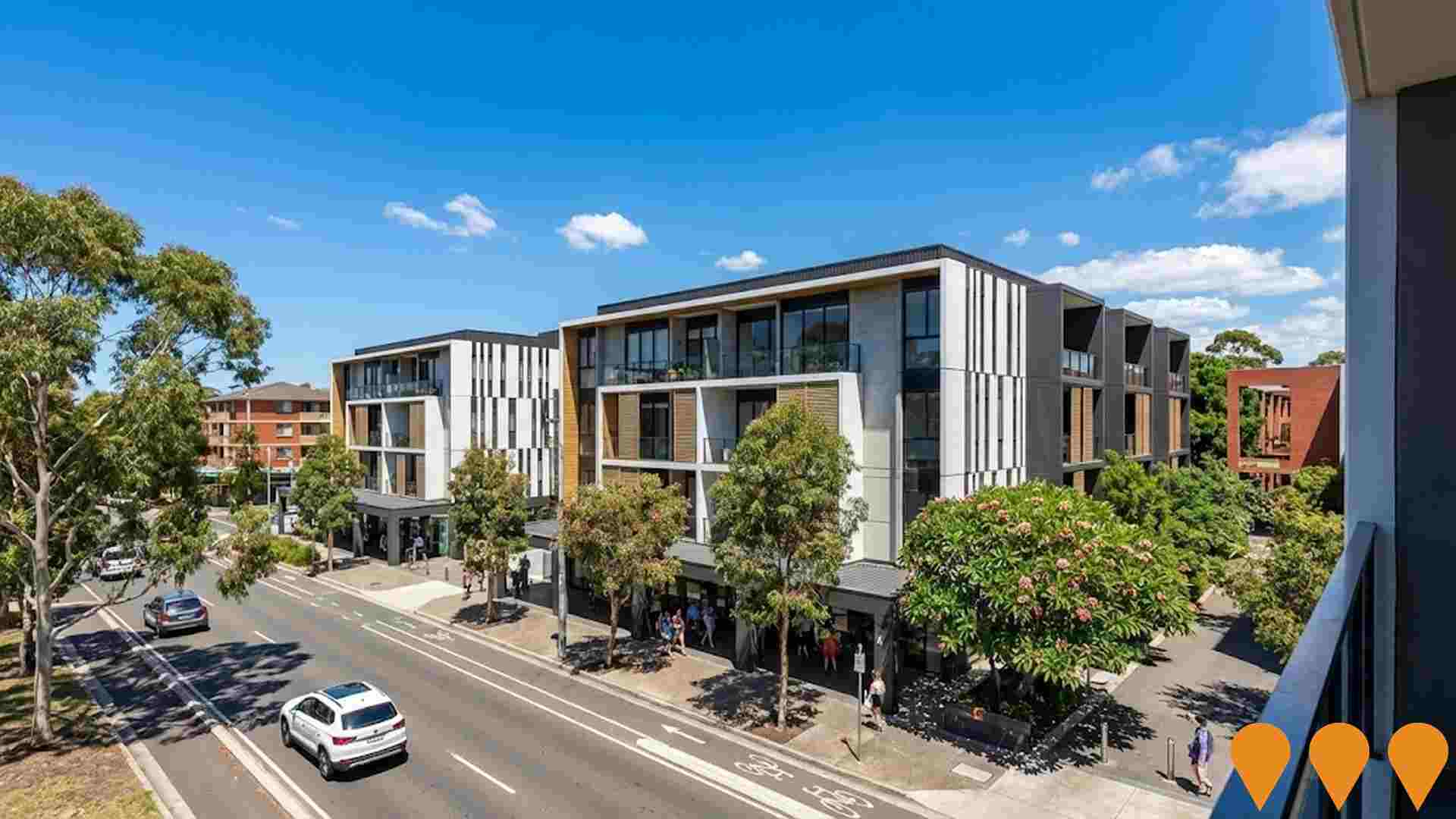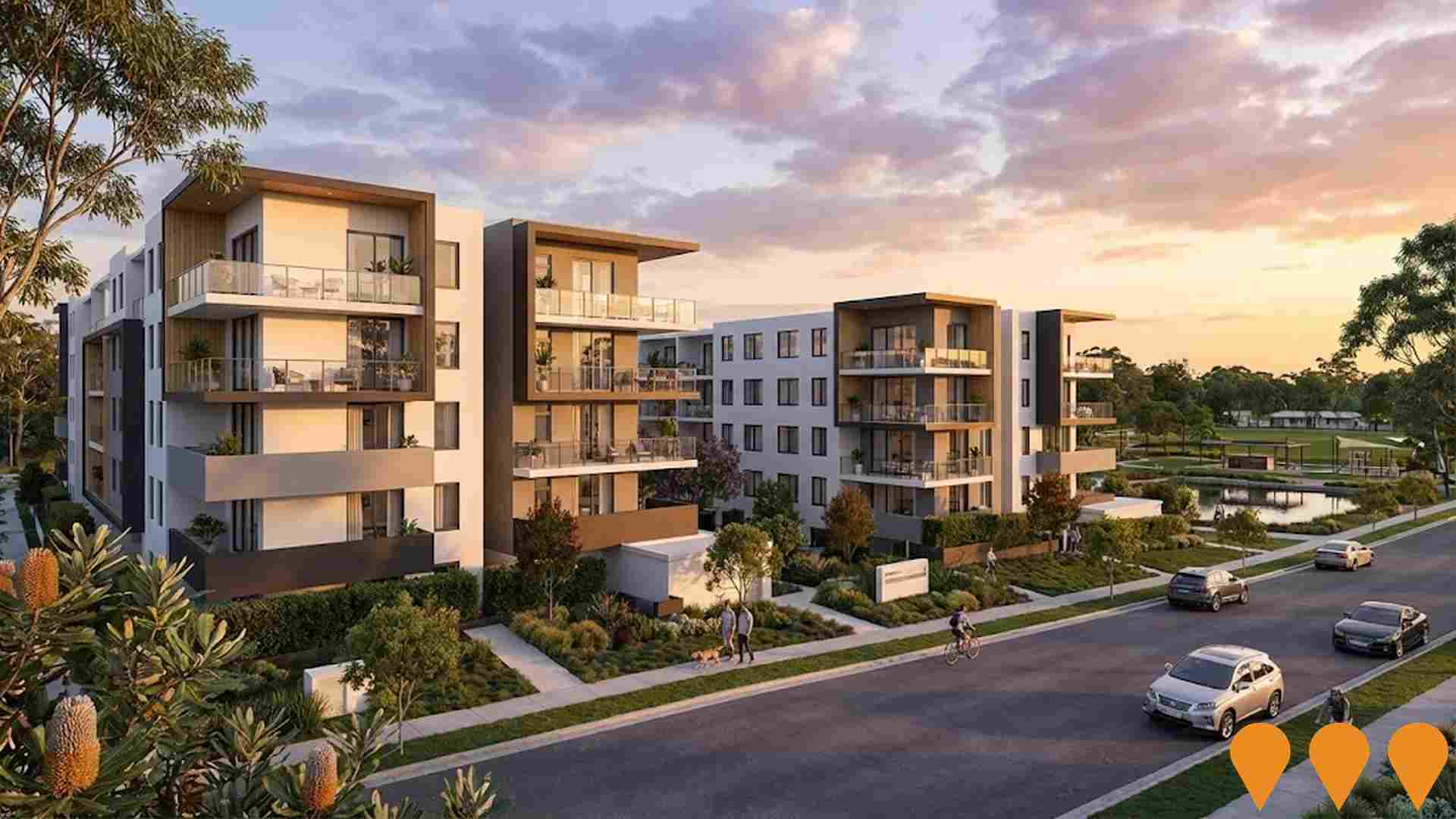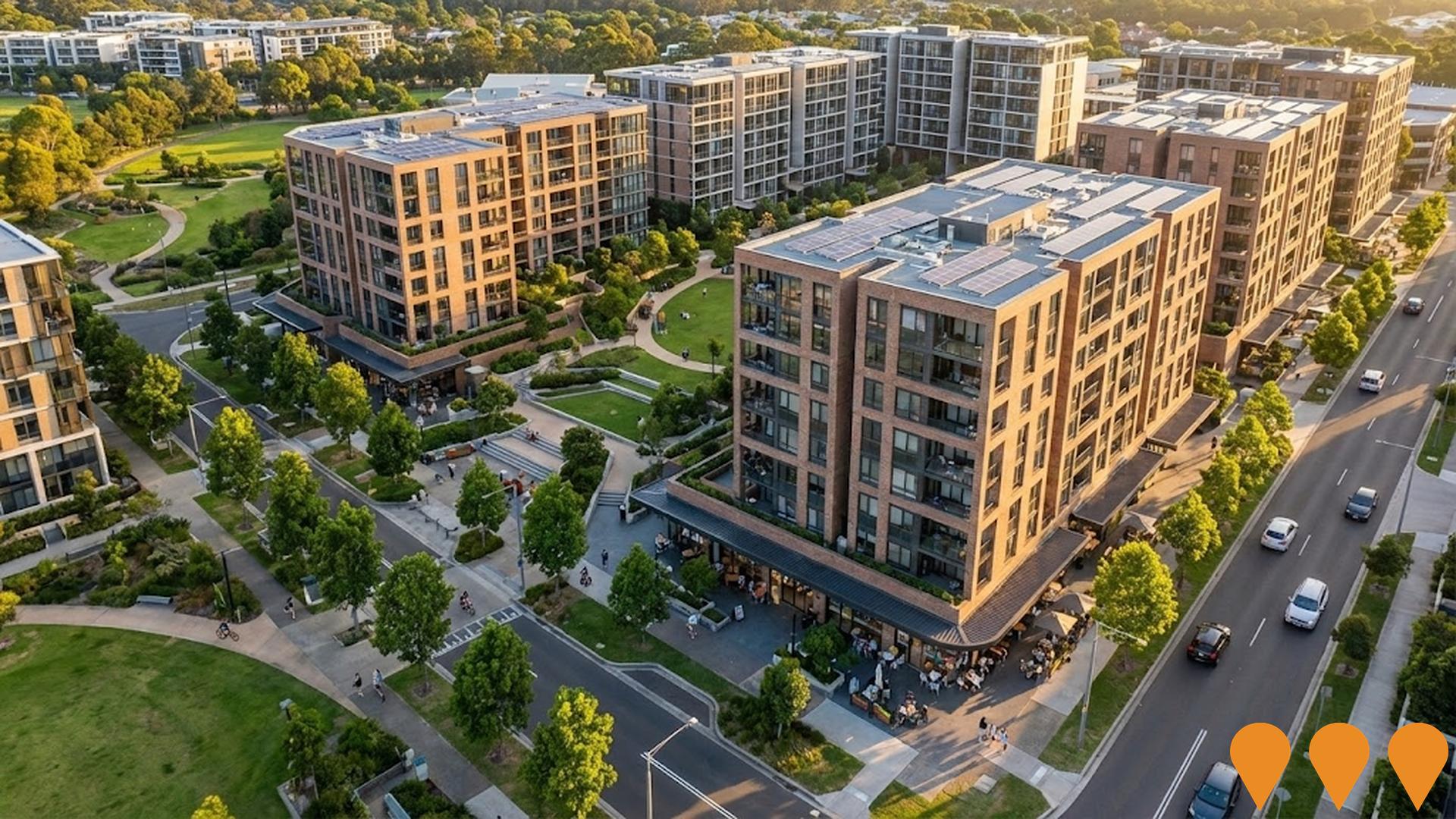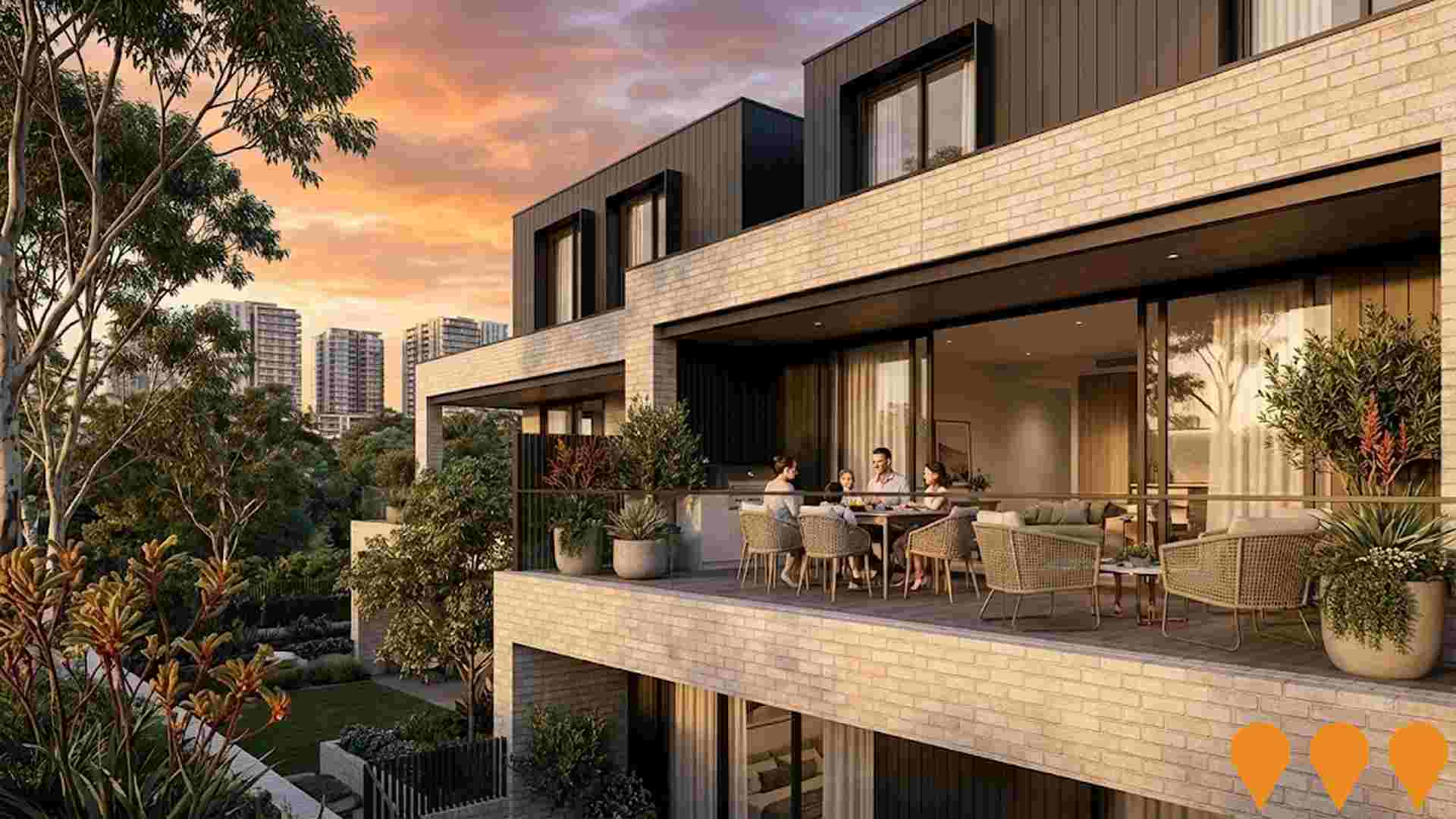Chart Color Schemes
est. as @ -- *
ABS ERP | -- people | --
2021 Census | -- people
Sales Activity
Curious about local property values? Filter the chart to assess the volume and appreciation (including resales) trends and regional comparisons, or scroll to the map below view this information at an individual property level.
Find a Recent Sale
Sales Detail
Population
Schofields - East lies within the top 10% of areas nationally in terms of population growth performance according to AreaSearch analysis of short and medium-term trends
Schofields - East's population is around 40,717 as of November 2025. This reflects an increase of 15,587 people since the 2021 Census, which reported a population of 25,130 people. The change is inferred from the estimated resident population of 35,895 from the ABS as of June 2024 and an additional 4,088 validated new addresses since the Census date. This level of population equates to a density ratio of 3,492 persons per square kilometer, placing it in the upper quartile relative to national locations assessed by AreaSearch. Schofields - East's growth rate of 62.0% since the 2021 census exceeded the state's growth rate of 6.7%. Population growth for the area was primarily driven by interstate migration, contributing approximately 73.8% of overall population gains during recent periods.
AreaSearch is adopting ABS/Geoscience Australia projections for each SA2 area, as released in 2024 with 2022 as the base year. For any SA2 areas not covered by this data, AreaSearch is utilising the NSW State Government's SA2 level projections, as released in 2022 with 2021 as the base year. Growth rates by age group from these aggregations are also applied to all areas for years 2032 to 2041. Considering the projected demographic shifts, exceptional growth is predicted over the period with the area expected to increase by 62,275 persons to 2041 based on the latest population numbers, recording a gain of 141.0% in total over the 17 years.
Frequently Asked Questions - Population
Development
The level of residential development activity in Schofields - East was found to be higher than 90% of real estate markets across the country
Schofields - East has seen approximately 1,345 new homes approved annually. Between FY2021 and FY2025, around 6,728 homes were approved, with an additional 68 approved in FY2026 as of now. On average, about 2.9 people moved to the area per new home constructed over these five years, indicating strong demand that supports property values.
The average construction cost value for these homes was around $204,000, which is below the regional average, suggesting more affordable housing options for buyers. This year alone, $37.8 million in commercial approvals have been registered, demonstrating robust commercial development activity. Compared to Greater Sydney, Schofields - East has seen 174.0% more development activity per person, offering ample choice for buyers despite recent moderation in development activity. This high level of activity reflects strong developer confidence in the location, which is significantly higher than the national average. The new developments primarily consist of 17.0% detached dwellings and 83.0% attached dwellings, focusing on higher-density living to create more affordable entry points for downsizers, investors, and first-home buyers. This shift from the current housing mix of 75.0% houses reflects reduced availability of development sites and addresses evolving lifestyle demands and affordability requirements. With around 130 people per approval, Schofields - East is a developing area with a projected resident growth of 57,426 by 2041.
Current construction rates appear balanced with future demand, maintaining steady market conditions without excessive price pressure.
Frequently Asked Questions - Development
Infrastructure
Schofields - East has very high levels of nearby infrastructure activity, ranking in the top 20% nationally
Changes in local infrastructure significantly affect an area's performance. AreaSearch has identified 57 projects that could impact this region. Notable ones include CASA at Sapphire Estate, Landcom Demonstration Precinct Schofields, Pelicana Green III, and Schofields Square Stages 2 & 3. The following list details those most relevant.
Professional plan users can use the search below to filter and access additional projects.
INFRASTRUCTURE SEARCH
 Denotes AI-based impression for illustrative purposes only, not to be taken as definitive under any circumstances. Please follow links and conduct other investigations from the project's source for actual imagery. Developers and project owners wishing us to use original imagery please Contact Us and we will do so.
Denotes AI-based impression for illustrative purposes only, not to be taken as definitive under any circumstances. Please follow links and conduct other investigations from the project's source for actual imagery. Developers and project owners wishing us to use original imagery please Contact Us and we will do so.
Frequently Asked Questions - Infrastructure
Schofields Town Centre
Schofields Town Centre is a priority precinct in Sydney's North West Growth Area being planned as a vibrant mixed-use centre around Schofields Station and the Sydney Metro Northwest line. The masterplan supports approximately 3,000 new dwellings, 10,000 m2 of retail/commercial floorspace, new public domain, community facilities, and two new primary schools. Rezoning was finalised in 2023 with development now progressing under the State Significant Precinct framework.
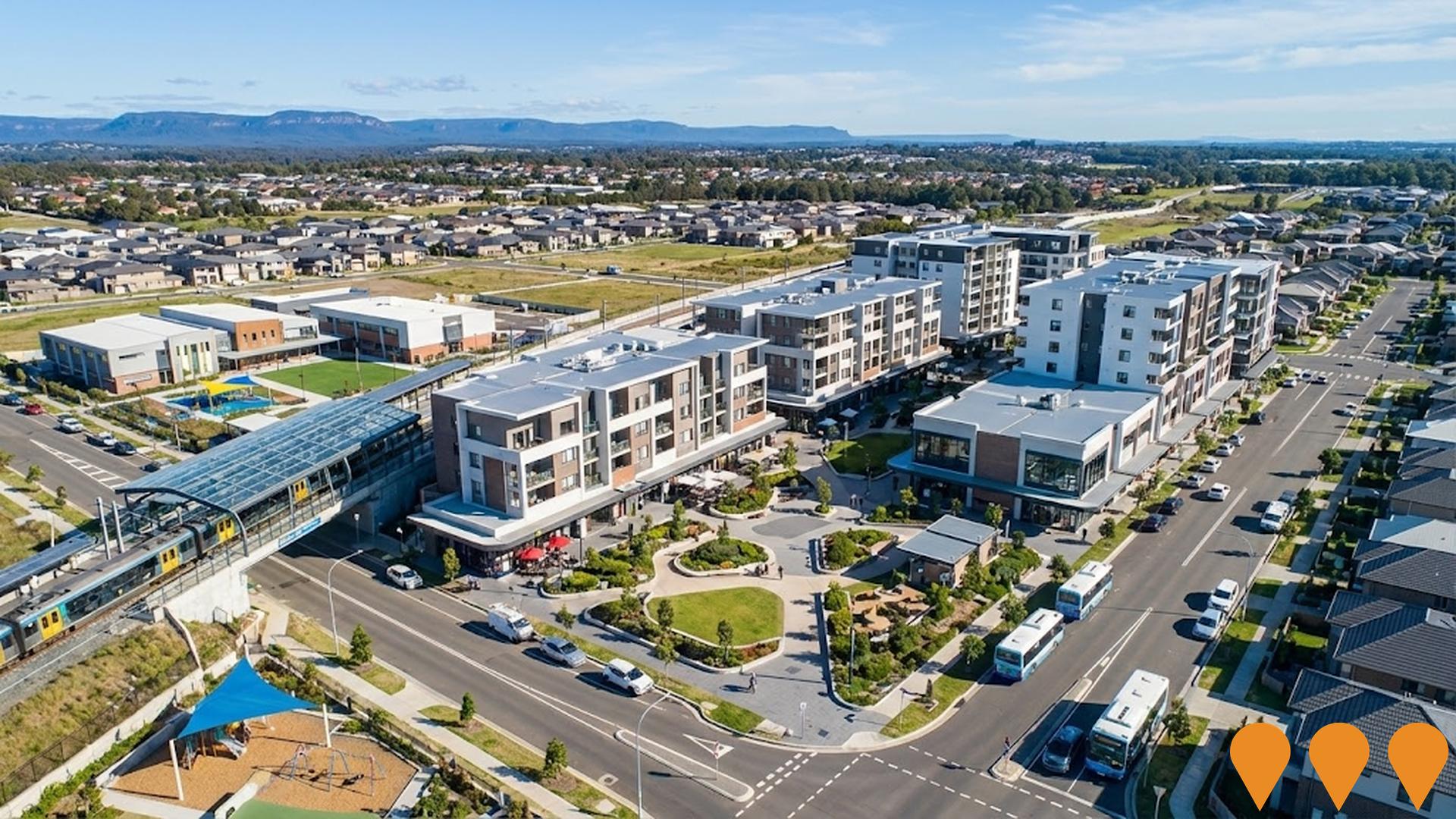
Tallawong Village
Master-planned mixed-use precinct by Deicorp adjacent to Tallawong Metro Station. Delivering 987 apartments (including 50 affordable housing units), 9,000-9,500 sqm retail/commercial space, childcare centre, 3,500 sqm public park and community facilities. Stage 1 (333 apartments + retail) completed and occupied in 2024-2025. Stages 2 and 3 under active construction throughout 2025 with completion expected 2026-2027.
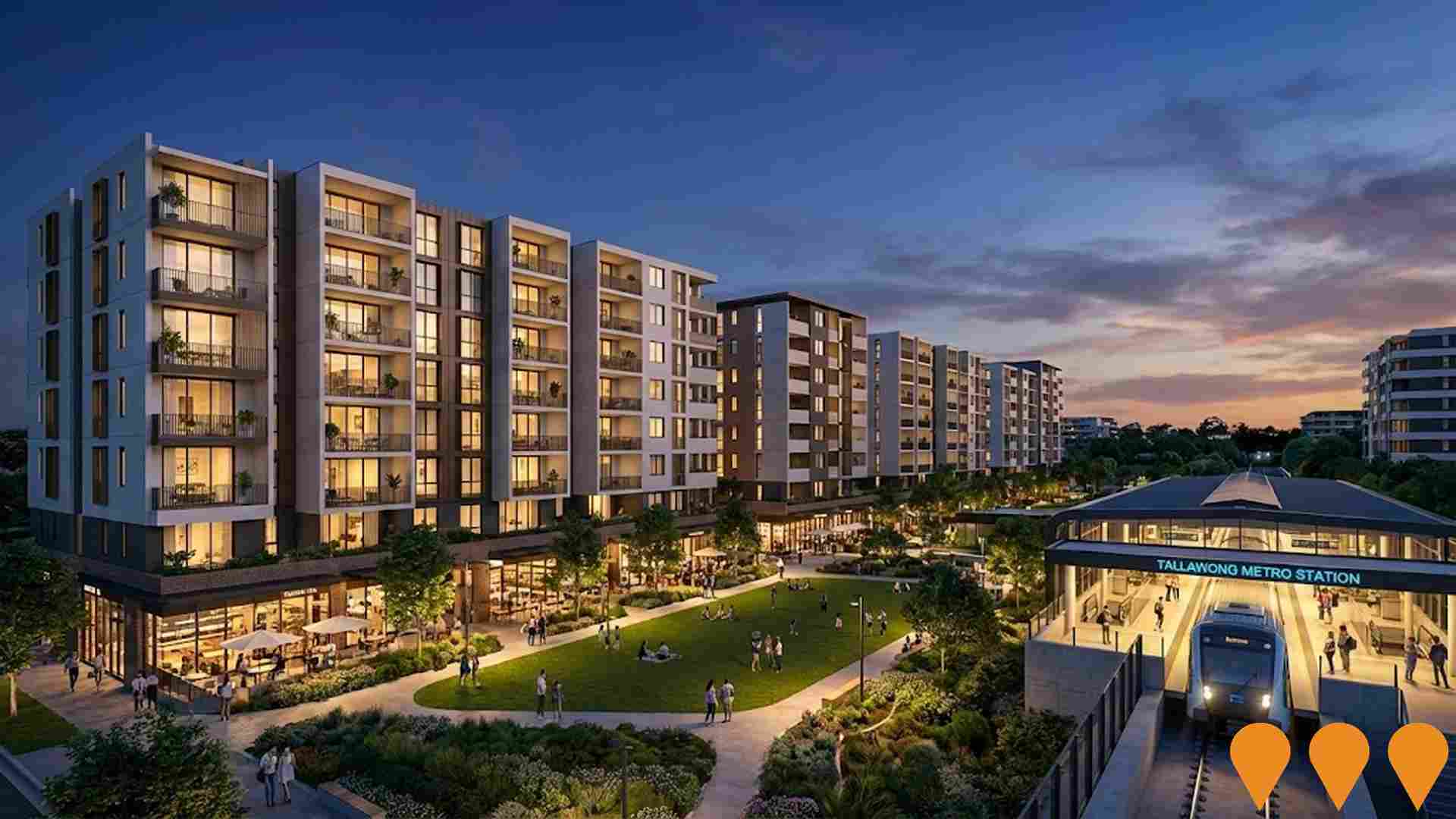
Akuna Vista (Nirimba Fields)
Master planned community comprising approximately 1,100 residential lots with 200 homes for Defence members. 136-hectare site includes sport and recreational facilities, community parks, multi-purpose sports courts, and a new K-6 Public Primary School. Village Centre with retail outlets proposed.

Schofields Square Stages 2 & 3
Mixed-use development comprising 468 apartments (including 74 affordable housing units), neighbourhood shops, 578 basement parking spaces, and 17,816 sqm of landscaped communal open space. Part of Stages 2 and 3 of the Schofields Square precinct with 42,831 sqm total gross floor area.
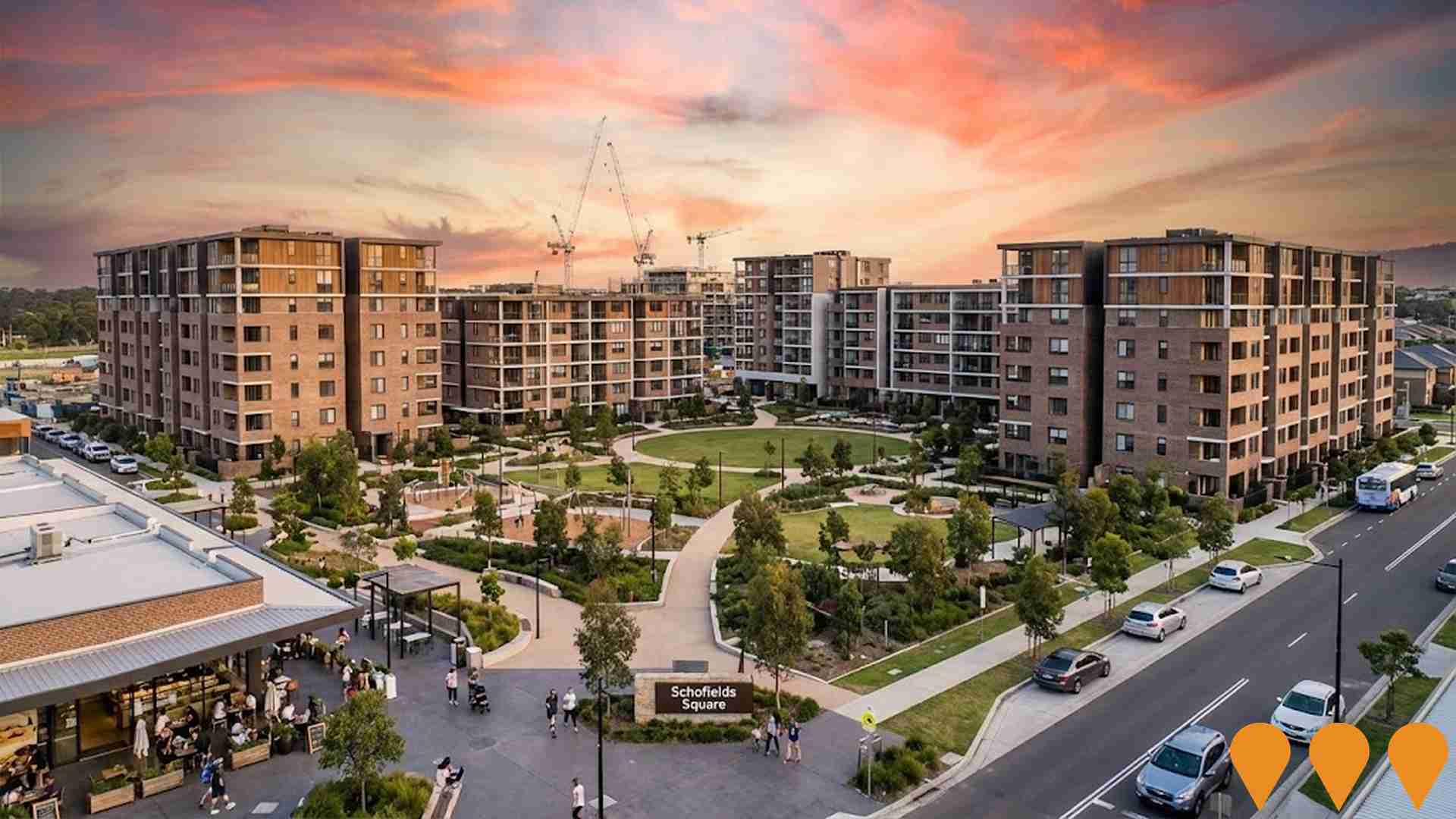
Tallawong Station Precinct South
Mixed-use transit-oriented development adjacent to Tallawong Metro Station featuring residential apartments, retail spaces, commercial offices, and public plaza. Designed to maximise access to public transport and create a vibrant community hub.

Landcom Demonstration Precinct, Schofields
A demonstration residential development by Landcom showcasing innovative housing diversity and green street design. The project will deliver at least 140 homes including terraces, manor homes, duplexes, and compact housing with at least 30% affordable housing for key workers. Features 20% more green verge than standard developments, increased tree canopy, and liveable green streets designed to encourage community interaction. Civil works have been completed with housing construction anticipated to begin in early 2026.
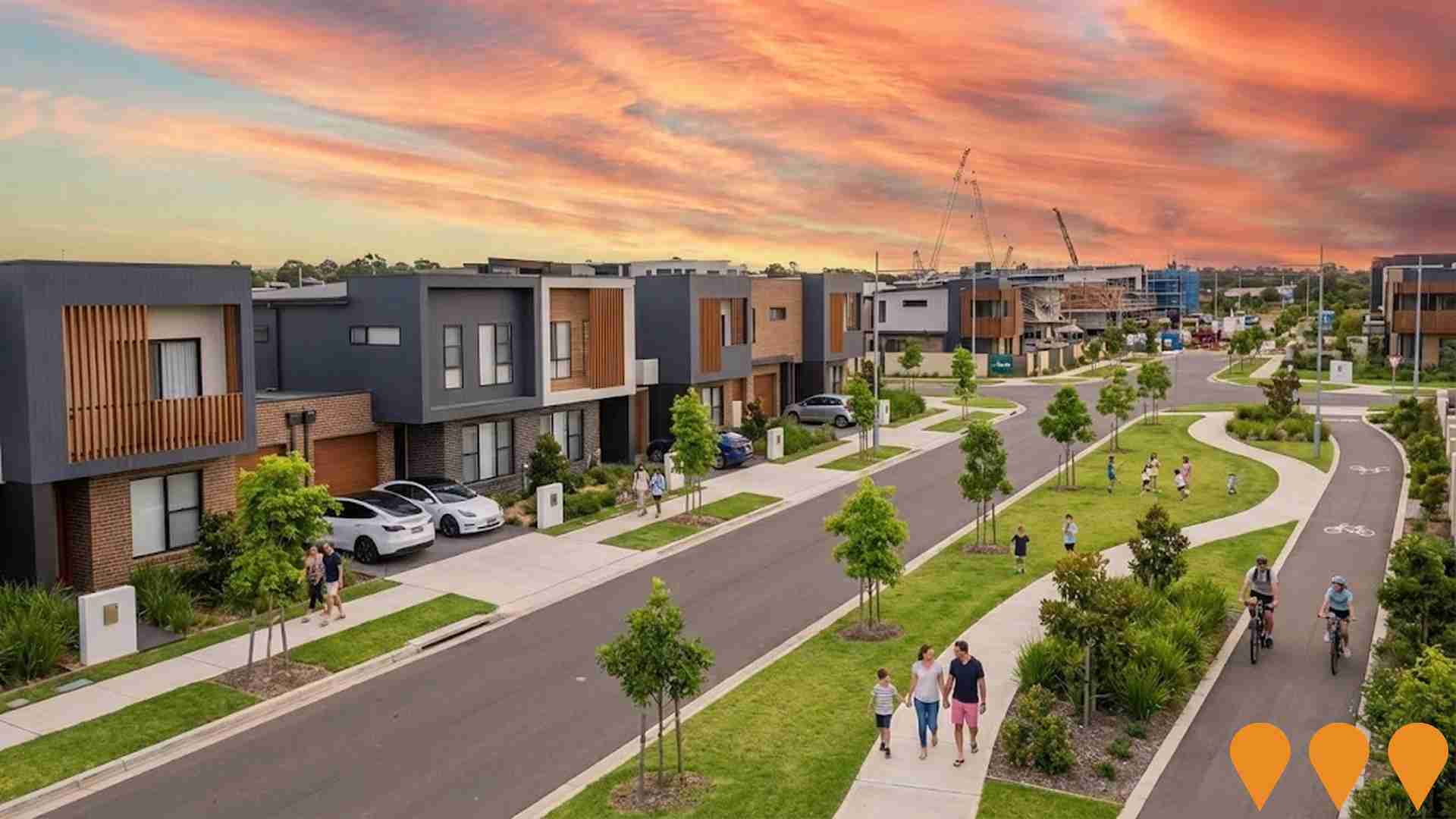
Tallawong Public School
New K-6 primary school with capacity for 1,000 students to serve the growing Tallawong and surrounding areas. Will feature modern learning spaces, library, hall, canteen, and extensive outdoor learning areas including playgrounds and sports facilities.
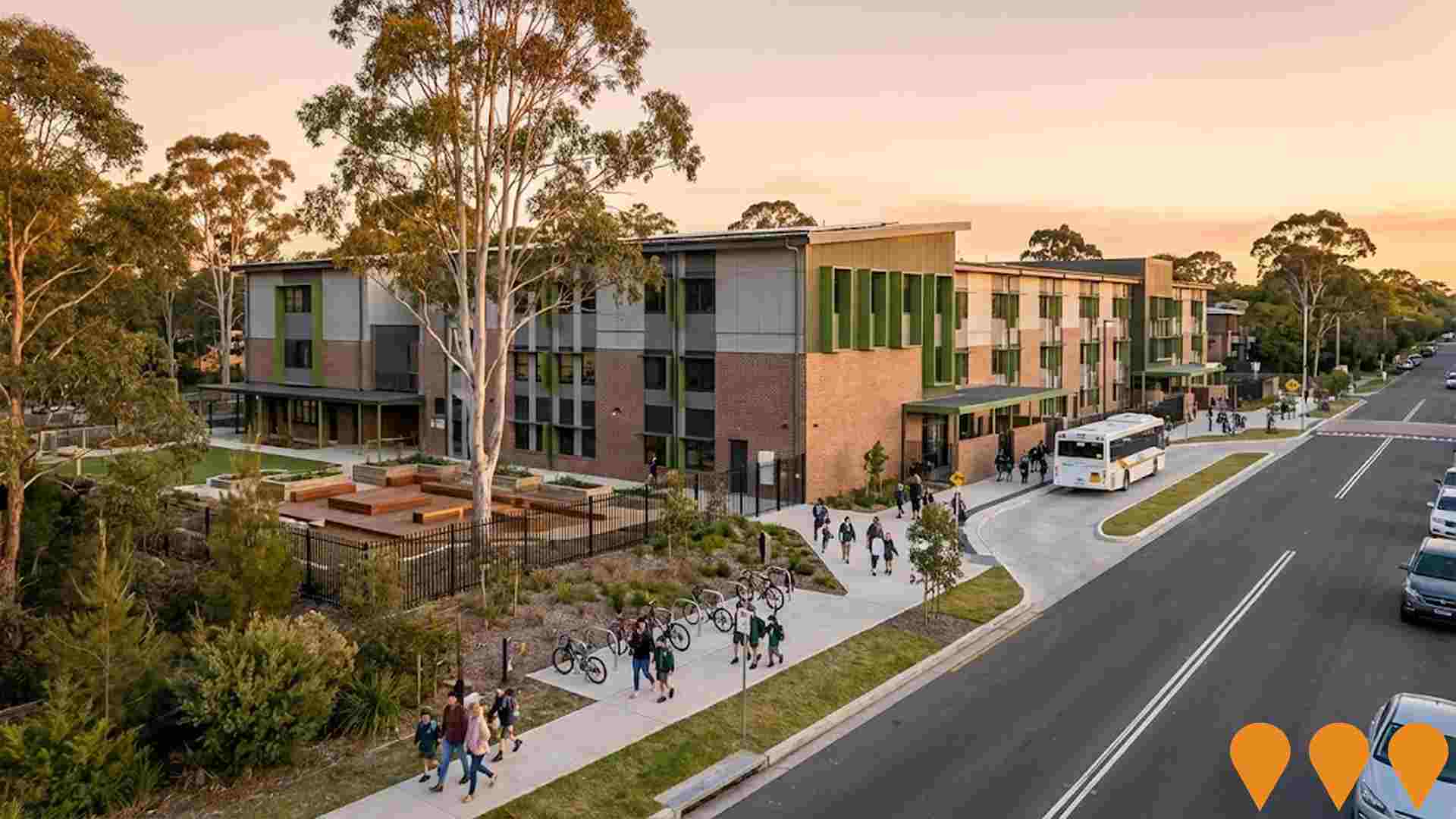
Reserve Embellishment - Tallawong Reserve and Rosenthal Park
The project involves upgrading two existing parks: Tallawong Reserve and Rosenthal Park, to enhance liveability and foster an active lifestyle. Upgrades include improved play areas, spectator seating, accessible pathways, new carparking, refurbished picnic areas, a multipurpose court, and tree planting across both reserves. The total project funding is approximately $2.1 million from the NSW Government's Western Sydney Infrastructure Grants Program.

Employment
AreaSearch analysis of employment trends sees Schofields - East performing better than 90% of local markets assessed across Australia
Schofields - East has an educated workforce with a notable technology sector presence. The unemployment rate is 2.1% as of June 2025, below Greater Sydney's rate of 4.2%.
Employment growth over the past year was estimated at 6.3%. There are 22,209 residents employed while workforce participation stands at 74.0%, higher than Greater Sydney's 60.0%. Key industries include health care & social assistance, professional & technical, and finance & insurance. Finance & insurance has an employment share of 1.5 times the regional level, while education & training employs only 6.9% locally compared to Greater Sydney's 8.9%.
Employment opportunities appear limited within the area. Between June 2024 and June 2025, employment levels increased by 6.3%, labour force grew by 6.5%, leading to a slight rise in unemployment rate of 0.2 percentage points. In contrast, Greater Sydney saw employment rise by 2.6% and unemployment increase by 0.3 percentage points. National employment forecasts from Jobs and Skills Australia (May 2025) project growth of approximately 7.0%% over five years and 14.2% over ten years for Schofields - East, based on industry-specific projections applied to the local employment mix.
Frequently Asked Questions - Employment
Income
The economic profile demonstrates exceptional strength, placing the area among the top 10% nationally based on comprehensive AreaSearch income analysis
Schofields - East had a median taxpayer income of $69,775 and an average of $80,830 in financial year 2022. This is higher than Greater Sydney's median income of $56,994 and average income of $80,856 during the same period. By September 2025, based on a 12.61% Wage Price Index growth since financial year 2022, estimated incomes would be approximately $78,574 (median) and $91,023 (average). Census data shows household, family, and personal incomes in Schofields - East are high, ranking between the 89th and 94th percentiles nationally. The income bracket of $1,500 - 2,999 captures 38.1% of the community (15,513 individuals), which is consistent with broader trends in the area showing 30.9% in the same category. Economic strength is evident with 42.8% of households earning high weekly incomes exceeding $3,000, supporting elevated consumer spending. High housing costs consume 21.4% of income, but strong earnings place disposable income at the 90th percentile nationally. The area's SEIFA income ranking places it in the 9th decile.
Frequently Asked Questions - Income
Housing
Schofields - East is characterized by a predominantly suburban housing profile, with a higher proportion of rental properties than the broader region
As per the latest Census data, dwelling structures in Schofields - East comprised 74.9% houses and 25.1% other dwellings (including semi-detached, apartments, 'other' dwellings), compared to Sydney metro's 84.9% houses and 15.1% other dwellings. Home ownership in Schofields - East was at 5.7%, with mortgaged dwellings at 55.1% and rented ones at 39.1%. The median monthly mortgage repayment was $2,817, higher than Sydney metro's average of $2,700, while the median weekly rent figure was $550, slightly above Sydney metro's $540. Nationally, Schofields - East's mortgage repayments were significantly higher than the Australian average of $1,863, and rents were substantially above the national figure of $375.
Frequently Asked Questions - Housing
Household Composition
Schofields - East features high concentrations of family households, with a lower-than-average median household size
Family households account for 85.6% of all households, including 56.5% couples with children, 18.4% couples without children, and 9.9% single parent families. Non-family households make up the remaining 14.4%, with lone person households at 11.3% and group households comprising 3.1%. The median household size is 3.2 people, smaller than the Greater Sydney average of 3.3.
Frequently Asked Questions - Households
Local Schools & Education
Schofields - East shows strong educational performance, ranking in the upper quartile nationally when assessed across multiple qualification and achievement indicators
Educational attainment in Schofields - East is notably high, with 52.9% of residents aged 15+ holding university qualifications, compared to 30.4% nationally and 32.2% in NSW. Bachelor degrees are the most common at 32.6%, followed by postgraduate qualifications (18.0%) and graduate diplomas (2.3%). Vocational pathways account for 22.6% of qualifications, with advanced diplomas at 10.4% and certificates at 12.2%. Educational participation is high, with 35.6% of residents currently enrolled in formal education, including 14.4% in primary, 7.9% in secondary, and 5.3% in tertiary education.
There are 10 schools operating within Schofields - East, educating approximately 9,674 students. The area has significant socio-educational advantages and academic achievement (ICSEA: 1101). The educational mix includes 6 primary, 3 secondary, and 1 K-12 school. School capacity exceeds typical residential needs, with 24.0 places per 100 residents compared to the regional average of 16.3, indicating Schofields - East serves as an educational center for the broader region.
Frequently Asked Questions - Education
Schools Detail
Nearby Services & Amenities
Transport
Transport servicing is good compared to other areas nationally based on assessment of service frequency, route connectivity and accessibility
Schofields - East has 101 active public transport stops. These include both lightrail and bus services. There are 88 individual routes operating from these stops, providing a total of 7,113 weekly passenger trips.
The accessibility of transport in the area is rated as good, with residents typically located within 200 meters of their nearest stop. On average, there are 1,016 trips per day across all routes, which equates to approximately 70 weekly trips per individual stop.
Frequently Asked Questions - Transport
Transport Stops Detail
Health
Schofields - East's residents boast exceedingly positive health performance metrics with very low prevalence of common health conditions across all age groups
Health outcomes data shows excellent results across Schofields - East, with very low prevalence of common health conditions across all age groups.
The rate of private health cover is exceptionally high at approximately 60% of the total population, which numbered 24,348 people in 2019. The most prevalent medical conditions in the area were asthma and mental health issues, affecting 5.1 and 4.3% of residents respectively, as per data from June 2021. A total of 84.6% of residents declared themselves completely clear of medical ailments, compared to 80.0% across Greater Sydney. The area has 4.7% of residents aged 65 and over, totalling 1,893 people in 2020, which is lower than the 7.8% in Greater Sydney. Health outcomes among seniors are particularly strong, broadly in line with the general population's health profile.
Frequently Asked Questions - Health
Cultural Diversity
Schofields - East is among the most culturally diverse areas in the country based on AreaSearch assessment of a range of language and cultural background related metrics
Schofields-East is among the most culturally diverse areas in Australia, with 60.5% of its population speaking a language other than English at home and 56.4%, born overseas as of 2021 data. Christianity is the main religion in Schofields-East, comprising 33.6% of people. However, Hinduism stands out at 28.4%, significantly higher than Greater Sydney's average of 20.2%.
In terms of ancestry, the top three groups are Other (25.5%), Indian (22.8%), and Australian (11.7%). Notably, Filipino representation is overrepresented at 4.9% compared to the regional average of 6.2%, Sri Lankan at 0.8% vs 0.9%, and Samoan at 0.9% vs 0.6%.
Frequently Asked Questions - Diversity
Age
Schofields - East hosts a very young demographic, ranking in the bottom 10% of areas nationwide
Schofields-East has a median age of 32 years, which is younger than Greater Sydney's average of 37 and significantly lower than Australia's national average of 38. Compared to Greater Sydney, Schofields-East has a higher proportion of residents aged 35-44 (26.4%) but fewer residents aged 55-64 (4.7%). This concentration of 35-44 year-olds is notably higher than the national average of 14.2%. Post-2021 Census data indicates that the 45 to 54 age group grew from 8.7% to 11.4%, while the 35 to 44 cohort increased from 24.7% to 26.4%. Conversely, the 25 to 34 age group declined from 19.1% to 14.9%, and the 0 to 4 age group dropped from 10.0% to 7.9%. Demographic projections suggest that by 2041, Schofields-East's age profile will change significantly. The 35 to 44 age cohort is projected to grow by 104%, adding 11,209 residents to reach a total of 21,979.

